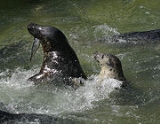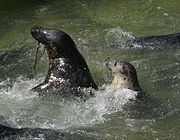
National Seal Sanctuary, Gweek
Encyclopedia

Pinniped
Pinnipeds or fin-footed mammals are a widely distributed and diverse group of semiaquatic marine mammals comprising the families Odobenidae , Otariidae , and Phocidae .-Overview: Pinnipeds are typically sleek-bodied and barrel-shaped...
pups. It is situated on the banks of the Helford River
Helford River
The Helford River is a ria located in Cornwall, England, UK, and not a true river. It is fed by a number of small streams into its numerous creeks...
in Cornwall
Cornwall
Cornwall is a unitary authority and ceremonial county of England, within the United Kingdom. It is bordered to the north and west by the Celtic Sea, to the south by the English Channel, and to the east by the county of Devon, over the River Tamar. Cornwall has a population of , and covers an area of...
, England
England
England is a country that is part of the United Kingdom. It shares land borders with Scotland to the north and Wales to the west; the Irish Sea is to the north west, the Celtic Sea to the south west, with the North Sea to the east and the English Channel to the south separating it from continental...
, UK and there is a road along the creek from the centre of Gweek
Gweek
Gweek is a civil parish and village in Cornwall, United Kingdom. It is situated approximately three miles east of Helston. The civil parish was created from part of the parish of Constantine by boundary revision in 1986...
village to the sanctuary's large car park.
Background
The origins of the seal sanctuary goes back to 1958 when the founder, Ken Jones, discovered a baby seal washed up on the beach near his home at St AgnesSt Agnes, Cornwall
St Agnes is a civil parish and a large village on the north coast of Cornwall, United Kingdom. The village is situated approximately five miles north of Redruth and ten miles southwest of Newquay....
. This was the first of many rescues. By 1975, the work had outgrown the single pool at St Agnes and a new site was found at Gweek
Gweek
Gweek is a civil parish and village in Cornwall, United Kingdom. It is situated approximately three miles east of Helston. The civil parish was created from part of the parish of Constantine by boundary revision in 1986...
. The Gweek site slowly grew, and today has five pools and a specially designed hospital.
Stated goals:
- To rescue and provide professional treatment for sick, injured or distressed marine mammals who are found around our shores.
- To rehabilitate or provide and maintain a home for the unfortunate animals that would otherwise would perish in the wild.
- To release the rehabilitated marine mammals safely back into their natural environment.
- To create a greater awareness of the marine environment through the work that is undertaken.
Rescue work
More than forty grey sealGrey Seal
The grey seal is found on both shores of the North Atlantic Ocean. It is a large seal of the family Phocidae or "true seals". It is the only species classified in the genus Halichoerus...
pups are rescued each year. The aim is to release them back into the wild having given them the best chance of survival.
The rescue normally starts with a call about an apparently abandoned pup. If the rescue team decide that the pup is in danger, then it is captured and taken to the sanctuary. Upon arrival, a full medical assessment is carried out, and a course of treatment is decided. Many of the pups are malnourished, with infected wounds. When the seal starts to recover and gain weight, they are transferred to convalescence pools. Here they interact with other seals learning to compete for their food.
After a few months, when the seal has reached a good weight and back to full health, they are released back into the sea, preferably near to where they were originally discovered. Before release they are given a flipper tag, and recently have been given a hat tag which falls off at the first moult. This provides useful information on the survival rate of the rescues.
The sanctuary aims to rehabilitate all rescued pups. It has an impressive record, between 1981 and 2011 only two seals have been diagnosed as never being able to survive in the wild. They have joined the full time residents at the sanctuary.
The long term residents are seals that unfortunately would never survive in the wild, due to health reasons, or just because they have been in captivity too long. Some of the residents share a pool with the rescue pups, providing good experience at feeding times, teaching the pups to fight for their food.

